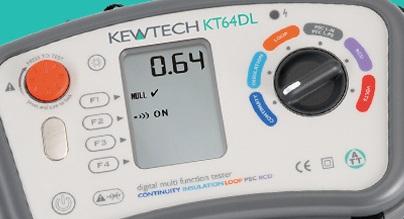Calibration: key to accuracy
Are you calibrating your test meters often enough? We look into the reasons why you might need to do it more than once a year.
Calibration is the key to efficient equipment, but are you doing it enough? You may think that an annual calibration keeps you covered, but that’s not always the case…
Why?
Calibration is essential – without it you could incorrectly install equipment or fail to identify faulty installations. Over time, the accuracy of a tester can change due to a range of different factors including:
- Sudden electricity surge
- A moisture intrusion after being left outside
- Accidental knocks causing damage to the meter’s internal operation
These issues can then cause the meter’s accuracy to drift from its normal state, causing it to become inaccurate. Calibration will check for these drifts and source the cause - if a slight imbalance is indicated, it’ll fix and restore your equipment to its correct working order. If errors are caused by faulty internal parts, calibration will help to discover and repair these issues.
BEW tip
We always suggest supplying leads, chargers and accessories that are used with your equipment as plenty of faults can be linked back to these.
How often?
Even if you’re dedicated to testing your equipment annually or at our regular Trade and Calibration Days, it’s also important to calibrate instruments if you suspect readings are incorrect or out of specification, or for the following reasons:
- Manufacturer specifications – these will indicate the recommended frequency.
- Before a large measuring project, make sure you calibrate your key instruments and then keep them securely stored and unused.
- If your equipment has been knocked, stored for a long period of time or absorbed a sharp impact.
- If you regularly test critical measurements, a shorter timeframe between calibrations will grant you better specifications.
- If your equipment is stored safely and securely, and you seldom take out critical measurements, it’s more cost effective to calibrate biannually.
Pro tip
Calibration should not affect your tester’s memory in any way, but it’s always worth downloading your results beforehand. If your equipment requires repair or replacements, it’s not a guarantee that test results will be retained.
Top three testers
Kewtech Digital 6 in1 KT64DL Multifunction Tester
- Anti-Trip Technology for full no trip LOOP testing on all RCD types
- Test button in probe as well as lockdown test button for ‘hands free’ testing
- Easy PFC & PSC measurement without the need to alter test probes
- 250/500/1000V insulation test voltages with auto discharge
- Auto-test memory for RCD testing with all results shown on one screen, so no scrolling
- Instant correct wiring status check
Fluke 1503 Insulation Resistance Tester
- 500/1000V insulation test voltages
- Live circuit detection prevents insulation test if voltage less than 30 is detected
- Remote test probe makes repetitive or hard-to-reach testing easy
- Auto-discharge of capacitive voltage for added user protection
Kewtech SMARTPAT Remotely Controlled PAT Tester
- A Wi-Fi enabled PAT tester remotely controlled from a phone or tablet.
- IT safe with 200mA earth test and 250V insulation option
- Portable RCD tests 10mA & 30mA
- For fast data collection and results saving, it works in connection with the KEWPAT app
- KEWPAT works with any brand of tester. You can download the KEWPAT APP to your iOS or Android device for free to enable you to go paperless. The APP manages data collection and risk assessment to fast data recording and product registers.
Here at BEW, we regularly hold Calibration Days throughout our branch network. For more information, our Sales staff at your local BEW branch are pleased to help.
